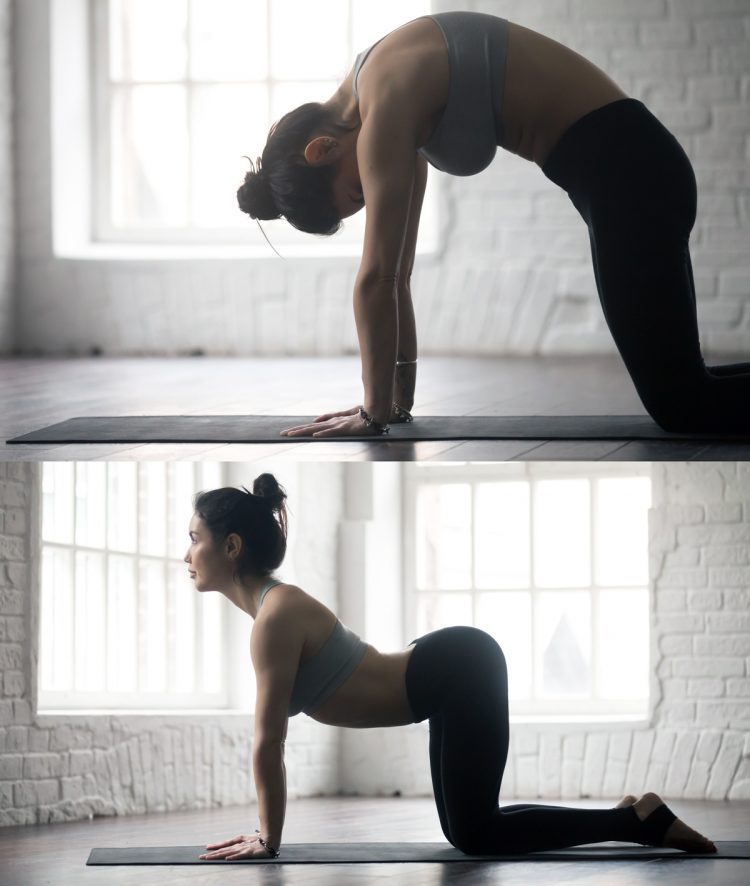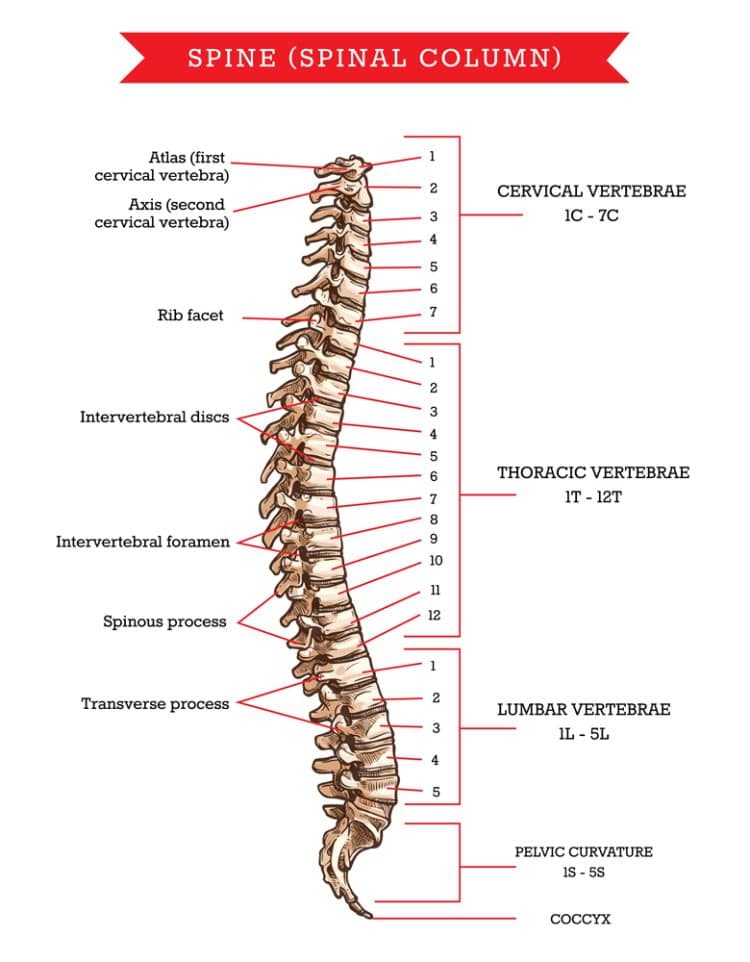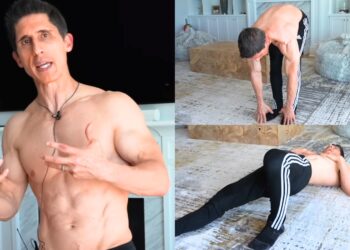Your spine is an amazing piece of biomechanical engineering. It consists of 33 individual bones, 25 intervertebral disks, numerous ligaments, and about 40 muscles, some of which are large and obvious, while others are small and almost invisible.
This complexity helps explain why over eighty percent of adults will experience some form of back pain during their lifetimes (1). While many of these cases are mild and short-lived, some of us will experience recurring, debilitating back pain.
One of the leading causes of back pain is prolonged sitting and sedentarism. Sitting is an entirely passive activity, and that can lead to weak, tight back muscles. Exercising can help, but even five or more hours of training per week cannot completely offset the effects of chronic sitting.
As such, if you want to avoid back pain, you need to strengthen your lower back with appropriate strength training exercises and minimize unwanted tension by stretching your back muscles. Becoming more posturally aware and sitting and standing up straight will also do your back a great deal of good.
In this article, we reveal the eight best exercises for stretching your lower back. Do a few of these movements daily to maintain lower back mobility and health.
Spine Anatomy
Doctors spend years learning about the intricacies of the spine, so it goes without saying that, in this article, we’re barely going to skim the surface of how your back works. That said, by the end of this section, you’ll have reasonable knowledge of the bones and muscles that make up your spine.
Level Up Your Fitness: Join our 💪 strong community in Fitness Volt Newsletter. Get daily inspiration, expert-backed workouts, nutrition tips, the latest in strength sports, and the support you need to reach your goals. Subscribe for free!
Vertebrae
Your spine is made up of 33 bones called vertebrae. Each individual vertebra is a different size and shape. Where vertebrae is the plural, vertebra is the singular form. The 33 vertebrae are divided into five sections:
- 7 cervical vertebrae – the neck
- 12 thoracic vertebrae – the upper back
- 5 lumbar vertebrae – the lower back
- 5 sacral vertebrae – the base of the spine
- 4 coccygeal vertebrae – the “tail bone”
The sacral and coccygeal vertebrae do not move and are fused. However, the lumbar, thoracic, and cervical vertebrae can flex, extend, and rotate. Of all the sections of the spine, the lumbar region is the most prone to injury as it tends to carry the greatest loads.
The vertebrae themselves are separated and cushioned by fibrous pads called intervertebral discs. These discs have a tough outer shell and a softer, gelatinous center. They’re flexible, so you can bend, extend, and rotate your spine.
While the intervertebral discs are VERY strong, they can be compressed, distorted, torn, and ruptured. Once damaged, they can be hard, if not impossible, to repair and may even have to be removed.
The spine itself is held together by ligaments. Ligaments are avascular, meaning they have a very poor blood supply. Like intervertebral discs, ligaments take a very long time to heal. Ligaments are inelastic, and while they will stretch a little, they do not “spring back” like rubber bands. Instead, they can become overstretched and lax.
Muscles
There is a long list of muscles that control the movements of the spine. Some, like rectus abdominus, are well-known and obvious. At the opposite end of the spectrum, there are tiny muscles located between the vertebrae that control smaller, individual movements.
The main muscles that control your spine are:
- Rectus abdominis – located on the front of your abdomen and responsible for flexion and lateral flexion of the spine.
- Obliques – the waist muscles responsible for lateral flexion and rotation of the spine.
- Erector spinae – a group of eight muscles that extends your spine and is also involved in lateral flexion.
- The core – the collective term for the midsection muscles that support your spine by creating intra-abdominal pressure (IAP). The core includes your rectus abdominis, obliques, erector spinae, transverse abdominis, multifidus, diaphragm, and pelvic floor muscles.
Despite its obvious complexity, the spine is only capable of four movements, which are:
- Flexion – bending forward
- Extension – bending backward
- Lateral flexion – bending sideways
- Rotation – twisting
These movements can be combined, for example, flexion and rotation, like when you do something like a twisting crunch.
Stretching the lower back often involves all of the structures listed above. That’s because none of them work in isolation. However, it IS possible to emphasize the lower back.
The Eight Best Lower Back Stretches
Lower back tightness affects everyone from time to time. Long periods spent sitting, driving, standing, or performing repetitive tasks can cause your back muscles to shorten and become tense.
The best way to avoid this problem is to stretch your back a few times each day, especially after being stuck in the same position for an extended period. If possible, stretch your lower back every couple of hours to keep your spine mobile.
Here are eight of the best exercises for stretching and mobilizing your lumbar spine.
Note: Lower back tightness is sometimes caused or made worse by tight hamstrings. If, after stretching your lower back it still feels tight, make sure you also spend time working on your hamstring flexibility. Check out this article to find out how.
1. Cat-Cow Pose
Cat/cow is a yoga pose that stretches your lower back and abs to mobilize your spine. This movement provides a gentle stretch, making it the ideal warm-up before more intense lower back stretches. If your lower back is stiff, you’re sure to feel better after a few rounds of cat/cows!

How to do it:
- Kneel on all fours with your shoulders directly over your hands and your hips over your knees. Lengthen your neck and look down at the floor. Your spine should be neutral, i.e., slightly arched.
- Lower your head, tuck your hips under, and lift the center of your spine up toward the ceiling, so you look like an angry cat arching its back. Imagine there is an invisible thread pulling your back upward.
- Next, raise your head, tilt your hips backward, and lower your abdomen down toward the floor.
- Alternate smoothly between these two positions 8-10 times.
Pro tip: Contract your abs and push your hands onto the floor to protract your shoulders and increase your range of motion for a deeper back stretch.
2. Dead Hang
The dead hang uses gravity to decompress your spine, stretch your shoulders, and lengthen your back muscles. This is an excellent exercise to do between sets of squats or overhead presses or any time you want to stretch your entire back, shoulders, and abs at the same time.
Level Up Your Fitness: Join our 💪 strong community in Fitness Volt Newsletter. Get daily inspiration, expert-backed workouts, nutrition tips, the latest in strength sports, and the support you need to reach your goals. Subscribe for free!

How to do it:
- Find somewhere suitable to hang. You should be able to touch the bar without jumping. Use a step or a bench to ensure you can comfortably reach the bar. Also, ensure that your feet are clear of the floor once you are hanging from the bar.
- Hold the bar with an overhand, slightly wider than shoulder-width grip.
- With your arms straight, hang from the bar with your body straight and your feet off the floor. Do not fully relax your shoulders. Instead, keep them active by pulling them slightly down and back. Do not hold your breath.
- Remain motionless – no swinging or twisting – for the duration of your set. When you are done, step rather than jump down as jumping will shock load your spine, negating some of the decompressing benefits of this exercise.
Pro tip: Use lifting straps if you want to hang longer and deemphasize the grip aspect of this exercise.
3. Stability Ball Lower Back Stretch
While dead hangs are a great way to stretch your back and lengthen your spine, they do depend heavily on your grip strength. This exercise is more passive and gentler, so you should be able to do it for longer. However, it still provides relief from lower back tightness and will help decompress your spine.
How to do it:
- Kneel behind a stability ball. Lean forward and rest your abdomen on the ball so your arms are on the floor in front of you.
- Relax and drape your body over the ball. Your head and lower body should hang down toward the floor to open your spine and stretch your back.
- Move up and down the ball to shift the emphasis to different parts of your spine.
- Relax for 1-3 minutes, or as long as you feel comfortable.
- Roll back onto your knees and then slowly stand up.
Pro tip: No stability ball? No problem! You can replicate this exercise by leaning across a table so your hips are on the edge. Again, let your legs hang down to gently stretch and open your lower back.
4. Child’s Pose
Child’s pose is a traditional yoga stretch for the lower back. It also helps mobilize your knees and ankles. This is a very gentle exercise that’s ideal for when your lower back is especially tight. It’s also an excellent exercise for use as part of a cool down as it encourages relaxation and recovery.
How to do it:
- Kneel on all fours so your hips are over your knees and your shoulders are over your hands.
- Ease your hips back and sit on your heels.
- Lower your chest down toward the floor while simultaneously extending your arms out in front of you. This is called an extended child’s pose.
- Hold this position for 1-3 minutes.
Pro tip: You may find this exercise uncomfortable if you have tight lats. In that case, bring your arms around to the sides of your legs to remove your lats from the movement so you can concentrate more on your lower back, like this:
5. Knees to Chest Stretch
This is arguably one of the most relaxing ways to stretch your lower back. In fact, you can even do it while you are in bed! This exercise gently flexes your entire spine and also stretches your glutes, providing instant relief for tight back muscles.
How to do it:
- Lie on your back and bend your legs, bringing your knees in toward your chest.
- Place your hands outside your legs and behind your knees.
- Gently pull your knees in toward your chest and hold.
- Remain in this position for 30-60 seconds, and then relax.
- You can place your hands on the fronts of your knees if you prefer but take care not to pull too hard and put too much stress on your joints.
Pro tip: Lift your head toward your knees to increase the stretch on your upper back.
6. Bent Leg Twist Stretch
Bending forward is just one way to stretch your lower back. Twisting is another effective way to reduce muscle tension around your lumbar spine. This bent leg twist is especially useful if you’ve been fixed in the same position for a long time, e.g., after a long drive.
How to do it:
- Lie on the floor with one leg bent and one leg straight. Place your opposite hand on your bent knee. Extend your other arm out at shoulder height.
- Using your arm for extra rotation, pull your knee across your body and down toward the floor. Try to keep your shoulders flat on the floor.
- Hold for the required duration and then swap sides.
Pro tip: You can also bring your legs together and rotate both at the same time. The extra weight may help you get into a deeper stretch.
7. Happy Baby Pose
Those yoga folks sure do like their lower back stretches! The happy baby pose looks kinda silly but is actually an enjoyable way to stretch your lower back, hamstrings, and glutes. Elevating your legs is also thought to increase blood flow and boost energy. This is another stretch you can do in bed before you get up to face the day.
How to do it:
- Lie on your back with your legs bent and feet flat.
- Lift your legs and grab the soles of your feet. Keep your knees bent.
- Gently pull your legs apart and toward your chest.
- Hold for 30-60 seconds, increasing the stretch as you feel your muscles relax.
Pro tip: In yoga, it’s traditional to do this exercise by holding your big toes. Try it – you may find that you feel more energized afterward.
8. Seated Twist
Nothing tightens up your lower back like spending long periods sitting in front of a computer or desk. This exercise can be done without moving away from your workstation, so you can do it frequently during the day to stop your back from tightening up in the first place. Set the alarm on your phone and do this exercise every hour you are at work.
How to do it:
- Sit on the edge of your chair, plant your feet firmly on the floor, and sit up straight. Extend your neck and pull your shoulders down and back so you’re in good posture.
- Cross your arms over your chest.
- Keeping your hips stationary, gently rotate your upper body to the left and right. Turn as far as you can without causing pain.
- You can also do this exercise while standing.
Pro tip: If you’re sitting in a swivel chair, you can do this exercise by rotating your legs instead of turning your upper body.
More Stretches:
- Don’t Just Sit There! 8 Useful Things to Do Between Sets in The Gym
- Essential 6-Minute Stretching Sequence for Immediate Muscle Relief
- Partner-Assisted Stretching: Just Lazy or the Key to Optimizing Your Flexibility?
- Age-Proof Your Body: The Ultimate Guide to Exercises That Prevent Mobility and Muscle Loss
- Unlock Your Hip Flexors: Assisted Prone Lying Quads Stretch Guide
- 10 Best Abs Stretches to Improve Flexibility
- Say Goodbye to Stretching: Relieve Upper Body Tension with This 10-Minute Foam Rolling Routine
- How a 2-Minute Hanging Habit Transforms Your Body (Science Explained)
Lower Back Stretches – Wrapping Up
Low back tension and stress are all too common. Prolonged sitting, poor posture, and even negative emotions can cause your muscles to become tight. Tense back muscles can cause acute and chronic pain and should not be ignored.
The good news is there are plenty of ways you can reduce lower back tension without spending a dime or taking time off work.
Try to stretch your lower back every couple of hours. Do it before you start to feel tightness in your muscles. Tightness is a sign that something is already wrong. Instead, do what you can to prevent tension from accumulating in the first place. For many people, simply getting up and walking around for a minute or two every hour can be helpful.
However, if you are suffering from actual back pain, you should seek medical advice before you start a regimen of stretching. In some cases, stretching could make things worse.
References:
1 – PubMed: The Rising Prevalence of Chronic Low Back Pain https://www.ncbi.nlm.nih.gov









